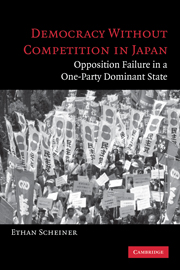Book contents
- Frontmatter
- Contents
- Tables and Figures
- Glossary of Abbreviations
- Acknowledgments and a Note on the Use of the Online Appendix
- Introduction: The Puzzle of Party Competition Failure in Japan
- 1 The Importance of Party Competition and a Model of Party Competition Failure
- 2 Opposition Failure in Japan: Background and Explanations
- 3 Clientelism and Its Determinants
- 4 The Impact of Clientelism and Centralized Government Financial Structure: Comparative Analysis
- 5 Local Opposition Failure in Japan
- 6 National-Level Opposition Failure: The Impact of Subnational-Level Weakness
- 7 Political Economy Changes and Their Impact on Party Systems: Comparative Analysis
- 8 Parallel Party Systems: Political Economy Changes and the Limits to Anti-Clientelist Appeals in Japan
- 9 The Problem of Organization and Coherence in Top-Down Party Formation
- 10 Conclusion: Democracy Without Competition
- References
- Index
8 - Parallel Party Systems: Political Economy Changes and the Limits to Anti-Clientelist Appeals in Japan
Published online by Cambridge University Press: 02 December 2009
- Frontmatter
- Contents
- Tables and Figures
- Glossary of Abbreviations
- Acknowledgments and a Note on the Use of the Online Appendix
- Introduction: The Puzzle of Party Competition Failure in Japan
- 1 The Importance of Party Competition and a Model of Party Competition Failure
- 2 Opposition Failure in Japan: Background and Explanations
- 3 Clientelism and Its Determinants
- 4 The Impact of Clientelism and Centralized Government Financial Structure: Comparative Analysis
- 5 Local Opposition Failure in Japan
- 6 National-Level Opposition Failure: The Impact of Subnational-Level Weakness
- 7 Political Economy Changes and Their Impact on Party Systems: Comparative Analysis
- 8 Parallel Party Systems: Political Economy Changes and the Limits to Anti-Clientelist Appeals in Japan
- 9 The Problem of Organization and Coherence in Top-Down Party Formation
- 10 Conclusion: Democracy Without Competition
- References
- Index
Summary
After seeing the rise of an anti-clientelist backlash in Italy and Austria, and the accompanying success of previously uncompetitive parties in those countries (Chapter 7), the question becomes why no such backlash penetrated and found success in Japan.
In reality, there was a similar backlash, which did help Japan's opposition, but it only occurred in particular parts of the country. In Japan, a divide emerged between groups that benefited from and groups that were harmed by the clientelist system and the pork barrel and protections that went with it. This division is most clearly evident in the differences between the urban and the rural areas of the country and led to the development in Japan of what might be called two parallel party systems: a one-party dominant system in rural areas and a competitive system in urban areas.
Although certain depressed urban regions may also support clientelism, the simplest rule of thumb is that rural areas support the clientelist structure, as a result of their lower education and skill levels – making people there less flexible in the face of threatened changes in the labor market – as well as the inefficient agricultural sector's general dependence on governmental subsidies and transfers of money for public works. By and large, voters in urban areas appeared to oppose clientelism and the features accompanying it.
- Type
- Chapter
- Information
- Democracy without Competition in JapanOpposition Failure in a One-Party Dominant State, pp. 156 - 183Publisher: Cambridge University PressPrint publication year: 2005



